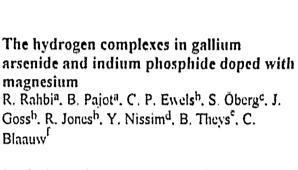 The hydrogen complexes in gallium-arsenide and indium-phosphide doped with magnesium
The hydrogen complexes in gallium-arsenide and indium-phosphide doped with magnesium
In GaAs and InP, Be, Zn and Cd replace a group III atom and behave as acceptors. These acceptors can be passivated by hydrogen and they form then complexes where the H atom is bonded to a group V atom nearest neighbor of the acceptor. The structure of these complexes is well-correlated with their spectroscopic properties. H can also be introduced into GaAs:Mg, but no passivation of Mg is observed whereas a new H-related complex is formed. On the contrary, InP:Mg can be passivated by hydrogen and a H-related LVM is also observed. We use spectroscopic methods to infer the structure of the H-related complexes and compare these findings with ab initio calculations. We also try to account for the different behavior of hydrogen in these semiconductors.
Go back